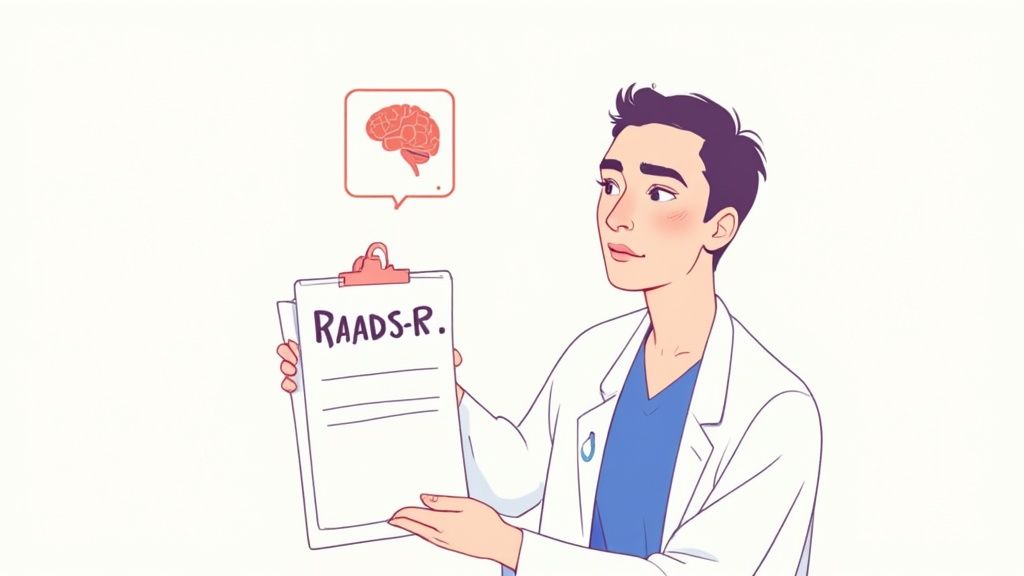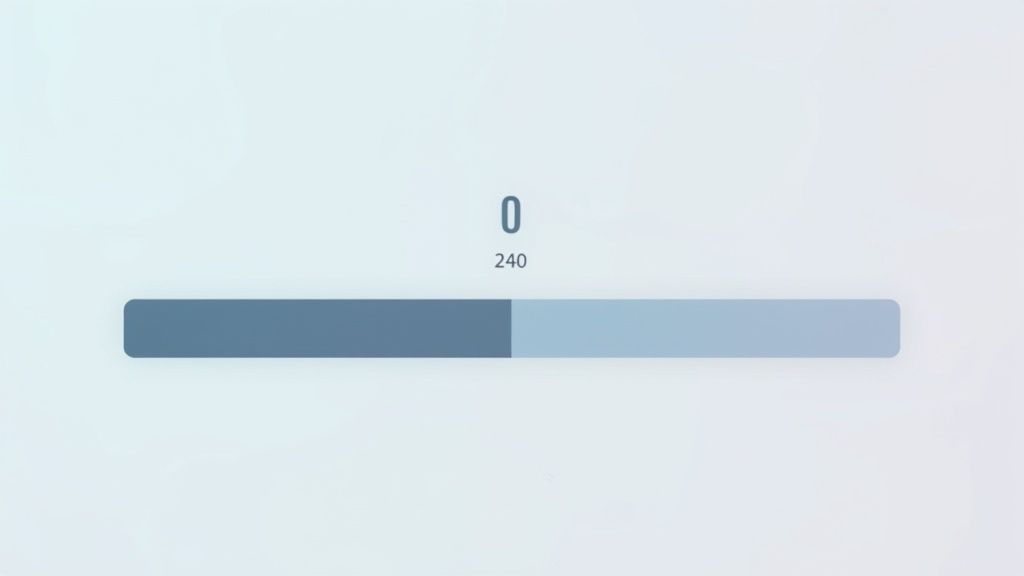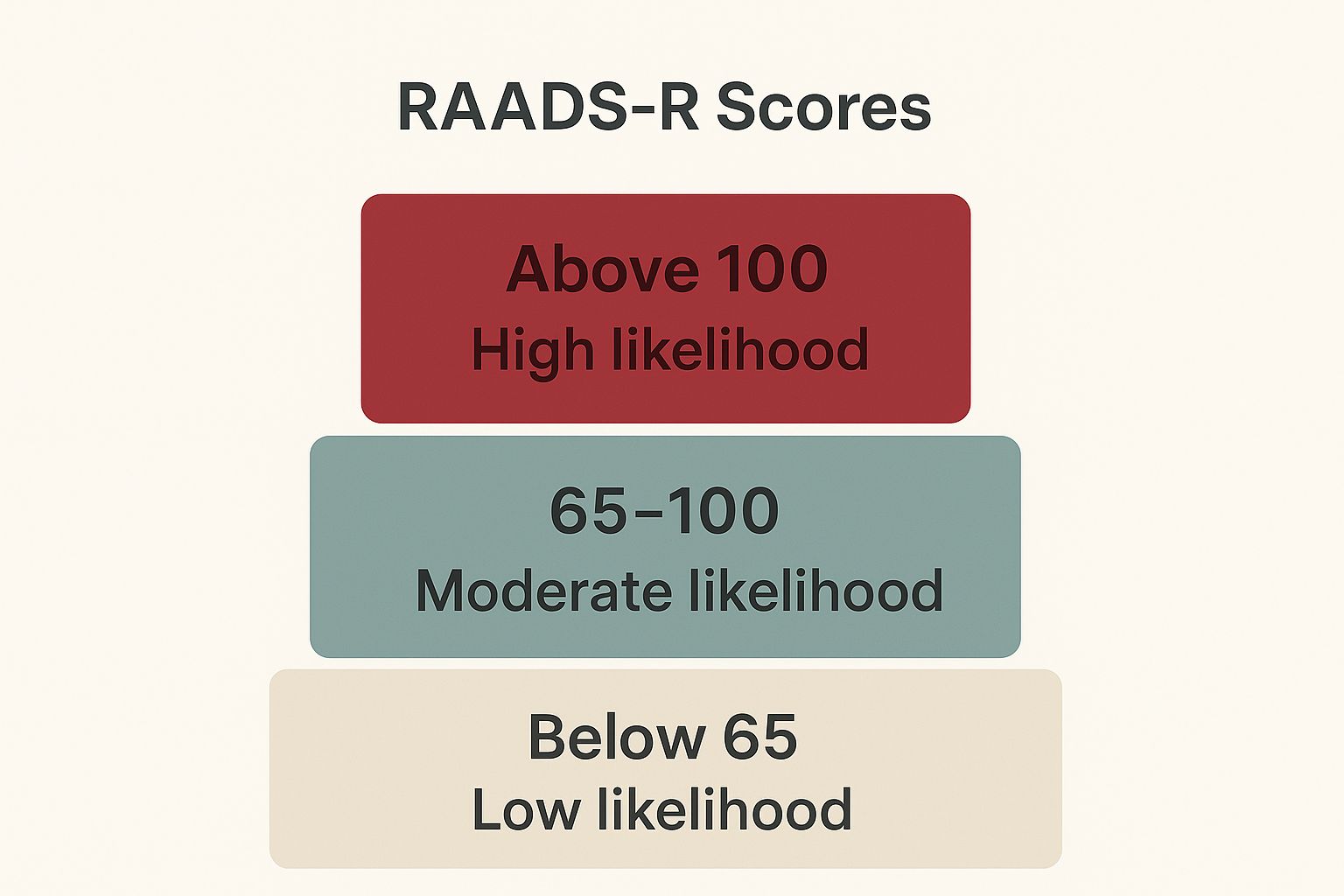When you get your results from the RAADS-R, you’ll see a total score that can range from 0 to 240. While the full range is broad, the number that really matters is 65.
Think of 65 as the clinical cutoff. If your total score is at or above this number, it suggests that your self-reported traits and experiences are consistent with an Autism Spectrum Disorder (ASD) diagnosis. This is a strong indicator that a formal clinical evaluation would be a good next step.
Decoding the RAADS R Score Range

It’s crucial to understand what the RAADS-R (Ritvo Autism Asperger Diagnostic Scale–Revised) actually is. It’s a self-report questionnaire, not a final diagnosis. Think of it less like a definitive lab test and more like a detailed map of your personal experiences, highlighting potential areas for a professional to explore with you.
The total score comes from your answers to 80 questions that are broken down into four key areas (or subscales). The 65 cutoff wasn't chosen randomly; research has shown that neurotypical individuals consistently score below this threshold, making it a reliable indicator for further assessment.
To make it even clearer, here’s a quick summary of what the scores generally mean.
RAADS-R Score Levels at a Glance
This table breaks down the main score thresholds and their clinical interpretation in simple terms.
| Score Range | General Interpretation |
|---|---|
| Below 65 | Your traits are generally not consistent with an ASD diagnosis. |
| 65 and Above | Your traits are consistent with ASD; a formal evaluation is advised. |
Remember, a high score doesn't automatically mean you are autistic. A score is just one piece of a much larger puzzle.
A high RAADS-R score is an invitation for a deeper conversation with a qualified professional. It provides a structured starting point for a comprehensive diagnostic evaluation, which includes clinical interviews and a review of developmental history.
Ultimately, understanding the RAADS R score range helps put your personal experiences into context. It offers a clear, evidence-based next step for anyone seeking diagnostic clarity and a better understanding of themselves.
Diving Into the RAADS-R Test
To really get a handle on what the RAADS-R score range means, we first need to look at the test itself. The RAADS-R is a questionnaire you fill out on your own. It’s designed to help adults spot autistic traits they may have had their whole lives, especially if they’ve never been diagnosed.
Think of it less like a definitive medical diagnosis and more like a detailed conversation starter. It's a way to gather information for a professional, helping to shine a light on patterns and experiences that might have been overlooked—particularly for those who have become experts at masking their traits.
The total score on the RAADS-R can go from 0 all the way up to 240. Research has found a pretty clear distinction: adults diagnosed with Autism Spectrum Disorder (ASD) typically score between 44 and 227, while neurotypical folks usually land somewhere between 0 and 65. This gap helps tell different neurotypes apart. You can explore the study on the RAADS-R's diagnostic accuracy for a deeper look at the numbers.
The Four Pillars of the RAADS-R
The test is built around four key areas, or subscales. Each one digs into a different aspect of a person's neurotype, helping to build a more complete and nuanced picture.
- Social Relatedness: This part looks at your experiences with social interactions. It asks about things like feeling empathy and how you form connections with other people.
- Circumscribed Interests: This area is all about those deep, passionate interests you might have. It also touches on your relationship with routines and a preference for things to be predictable.
- Language: Here, the questions focus on how you process and use language. For example, do you tend to take phrases very literally?
- Sensory-Motor: This subscale assesses sensory sensitivities—how you react to light, sound, or touch—along with things related to motor coordination.
By breaking down experiences into these four pillars, the RAADS-R provides a structured way to explore the nuances of one's inner world, moving beyond just a single score.
Understanding what these pieces measure is the first real step toward interpreting what your score actually means. If you're curious to learn more, you can take a closer look at our guide on the RAADS-R test.
How the RAADS-R Scoring System Works
To really get a handle on the RAADS-R score range, it helps to first understand how that final number comes together. The test itself is made up of 80 questions, and your answers all contribute to a total score that can land anywhere from 0 to 240. But it’s not just one big, monolithic number; it's built from four distinct areas of experience.
Think of it like a personality profile in a game. Instead of a single "power level," you have different stats—strength, intelligence, charisma—that combine to paint the full picture. The RAADS-R uses a similar logic, breaking down autistic traits and experiences into four specific subscales. This detailed structure is what gives the final score its depth and meaning.
Each of these subscales offers a different piece of the puzzle, helping to clarify the "why" behind your total score.
Breaking Down the Four Subscales
The scoring system sorts your answers into four key domains, each shining a light on a different facet of the neurodivergent experience. This method gives you a much more nuanced view than a single, flat score ever could.
- Social Relatedness: This area dives into your internal world of social interactions, empathy, and how you form connections. It’s less about how you act and more about how you feel when relating to others on an emotional level.
- Circumscribed Interests: This section is all about your deep passions, specialized hobbies, and a preference for routine. It looks at the intensity and focus of your interests, which are often a source of great joy and expertise.
- Language: The questions here get at how you process and use language. It often highlights tendencies toward very literal interpretations, a unique communication style, or challenges with the unwritten rules of conversation.
- Sensory-Motor: This domain explores your sensitivity to the world around you—things like light, sound, textures, and touch. It also covers experiences related to physical coordination and repetitive, self-soothing behaviors (stimming).
Your total RAADS-R score is simply the sum of your scores from these four subscales. Looking at your individual subscale scores can offer powerful insights into your specific strengths and challenges.
This visual gives a great overview of how clinicians generally interpret the total score.
As the infographic shows, a total score above 65 is often seen as the key threshold. It doesn't mean you are autistic, but it strongly suggests that a formal evaluation with a professional could be a valuable next step.
Interpreting Your RAADS R Score
So, you've finished the questionnaire and have a number in front of you. A score from any test is just data until you understand the story it tells. After completing the RAADS-R, that number is a valuable piece of your story, helping to translate your lived experiences into a more concrete result.
While you may have heard the official cutoff is 65, the full RAADS R score range paints a much more detailed picture. Think of your score less as a simple pass/fail and more as a point on a spectrum of likelihood. It helps show where your traits fall in relation to established patterns seen in both autistic and neurotypical adults. A higher score just means your experiences align more closely with those of diagnosed autistic individuals.
It's critical to remember this: scoring high on the RAADS-R is not a diagnosis. It’s an indicator—a strong signal that your neurotype shares characteristics common in autism. For many, it's the sign that pursuing a professional evaluation is a logical and often validating next step.
Understanding the Score Brackets
To give you a clearer picture, the total score range is broken down into several categories. This structure helps translate your number into a more practical insight about the potential presence of autistic traits.
- 0–25: Indicates no significant signs of autism.
- 26–50: Suggests minimal, non-clinical autistic traits.
- 51–90: Represents a moderate presence of traits, a bracket that includes the key cutoff of 65.
- 91–130: Signals a strong presence of autistic features.
- Above 130: Indicates a very high likelihood, with traits overwhelmingly consistent with an ASD profile.
These nuanced brackets move beyond a single number, offering a more complete view.
The RAADS-R is designed to be highly sensitive, meaning it's excellent at identifying individuals who may be autistic. However, it's a starting point, not the final word. A formal diagnosis requires the expertise of a clinician who can consider your full developmental history.
This is exactly why the RAADS-R is such a powerful screening tool. Its high sensitivity makes it unlikely to miss potential signs of autism, flagging individuals who would benefit most from a comprehensive assessment. It functions similarly to other screeners, like the Autism Spectrum Quotient, by empowering you with data-driven insights. Ultimately, it's a tool to guide your journey toward self-understanding and, if needed, formal diagnosis.
How Professionals Use the RAADS-R Test
It's crucial to understand that the RAADS-R is a screening tool, not a diagnostic one. Think of it like a preliminary survey a doctor might give you—it helps flag areas that need a closer look, but it doesn't give you the final answer. Its main job in a professional setting is to gather structured, self-reported information that points the way for a much more in-depth clinical evaluation.
A high score on the RAADS-R is a strong signal to investigate further, not a conclusion in itself. Clinicians use this score as a jumping-off point for a conversation, weaving it together with other vital information to build a complete diagnostic picture.
The Role in a Comprehensive Evaluation
A formal diagnosis is a detailed process that goes way beyond a single questionnaire. The RAADS-R is just one piece of a much larger puzzle.
A complete diagnostic process includes:
- Clinical Interviews: Deep, meaningful discussions about your personal experiences, challenges, and strengths.
- Developmental History: A thorough look back at your childhood, how you developed socially, and your communication patterns over time.
- Behavioral Observations: A clinician’s direct observations of how you interact and communicate in real-time.
This holistic approach is the gold standard for getting an accurate diagnosis. If you're thinking about what comes next, learning more about professional autism screening for adults can bring some valuable clarity to the journey. And to help manage the demanding task of recording these detailed discussions and interpretations, many professionals are now using advanced tools like AI clinical documentation solutions.
Understanding Test Limitations
While the RAADS-R is great at picking up on potential autistic traits, it's not foolproof. Research has shown that it has high sensitivity but lower specificity. In plain English, that means it’s very good at catching true positives but can also create false positives.
One 2021 study found the RAADS-R had 100% sensitivity in identifying diagnosed autistic adults but only 3.03% specificity in ruling out those without autism. This means that while it rarely misses an actual case, it can sometimes flag individuals who might not end up with an autism diagnosis after a full evaluation. Read the full research about these findings.
This is precisely why a clinician's expertise is irreplaceable. A skilled professional can tell the difference between traits that are genuinely part of an autistic profile and those that might come from other conditions like social anxiety or trauma, ensuring the final diagnosis is both accurate and thoughtful.
Answering Your Questions About RAADS-R Scores
So, you’ve taken the RAADS-R and have your score. Now what? It's completely normal to have questions swirling around. Let's walk through some of the most common ones to help you figure out what this number really means for you.
Does a High Score Mean I’m Autistic?
Not necessarily, but it’s a very strong clue. A score at or above the 65 threshold means your self-reported experiences line up well with how many autistic adults describe their own lives.
Think of it like a smoke detector. When it goes off, it’s telling you there’s a good chance of fire, but it can't tell you what started it or how big it is. The RAADS-R is a screening tool—it spots the potential for autism, but it isn’t a diagnosis on its own.
A high RAADS-R score is a powerful starting point. It gives you concrete data to bring to a professional, helping them understand your experiences and decide if a formal evaluation makes sense.
What If My Score Is Below 65?
A score below the 65 cutoff suggests that you don't share many of the traits common in an Autism Spectrum Disorder (ASD) profile. In most cases, it means you're probably not autistic.
But no test is perfect. If you took the test and still feel a deep connection to the experiences of autistic people, don't dismiss your gut feeling. Your lived experience is more important than a single number. It's always worth discussing your concerns with a professional who specializes in neurodiversity. They can offer a much more nuanced perspective.
What Should I Do with My Score?
Your score isn’t a label—it’s a piece of information to guide your journey of self-discovery. Here are a few ways to use it:
- Dive Deeper: Let your score be the spark that encourages you to learn more about autism in adults. Look for resources that talk about how autism presents in people who share your gender and background.
- Talk to a Professional: If your score is high (or even if it’s not, but you still have questions), consider finding a clinician who specializes in adult ASD evaluations.
- Find Your People: Explore online communities, forums, and social media groups for autistic adults. Hearing from people with similar experiences can be incredibly validating, whether you have a formal diagnosis or not.
Ultimately, your RAADS-R score is just a tool. It’s there to empower you with knowledge and help you take the next step that feels right for you.
Are you ready to move from screening to diagnostic clarity? The specialists at Sachs Center are experts in adult ADHD and Autism evaluations, providing compassionate and accurate assessments entirely online. Book your virtual evaluation today.


